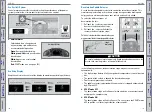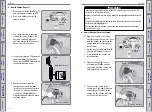
118 |
| 119
HANDLING THE UNEXPECTED
HANDLING THE UNEXPECTED
Emergency Power System Off
The POWER button may be used to stop the power system due to an emergency
situation even while driving. If you must stop the power system, choose one of
the following operations:
• Press and hold the POWER button for two seconds, or
• Firmly press the POWER button three times.
The steering wheel will not lock. However, because turning off the engine
disables the power assist the engine provides to the steering and braking
systems, it will require significantly more physical effort and time to steer and
slow the vehicle. Use both feet on the brake pedal to slow down the vehicle and
stop immediately in a safe place.
The gear position automatically changes to Park (P) after the vehicle comes to
a complete stop. Then the power mode changes to VEHICLE OFF.
Trying to lift or tow your vehicle by the bumpers will cause serious damage.
The bumpers are not designed to support the vehicle’s weight.
Improper towing such as towing behind a motorhome or other motor vehicle
can damage the transmission.
Any other towing method will damage the vehicle’s drive system.
NOTICE
Emergency Towing
Call a professional towing service if you need to tow your vehicle.
This vehicle requires a flat-bed tow vehicle
: The operator loads your vehicle
on the back of a truck.
Do not press the button while driving unless it is absolutely necessary for the
power system to be switched off.
NOTICE
Driving on an extremely underinflated tire can cause it to overheat. An
overheated tire can fail. Always inflate your tires to the specified pressure.
NOTICE
Tire Pressure Monitoring System (TPMS)
Monitors the tire pressure while you are driving.
If your vehicle’s tire pressure becomes
significantly low, the low tire pressure
indicator comes on and a message
appears.
n
What to Do
Stop your vehicle in a safe place.
Check the tire pressure and adjust the
pressure to the specified level on the
label on the driver’s doorjamb.
n
TPMS Calibration
Any time you inflate, change, or rotate one or more of the tires, you need to
recalibrate the system. The calibration process requires approximately 30
minutes of cumulative driving at speeds between 30–65 mph (48–105 km/h).
The vehicle must be stopped to begin calibration, and the process finishes
automatically.
Use the touchscreen to make and
enter selections.
1. From the HOME screen, select
Settings.
2. Select Vehicle.
3. Select TPMS Calibration.
4. Select Calibrate.
Содержание Clarity 2018
Страница 1: ...2018 ELECTRIC OWNER S GUIDE ...
















































